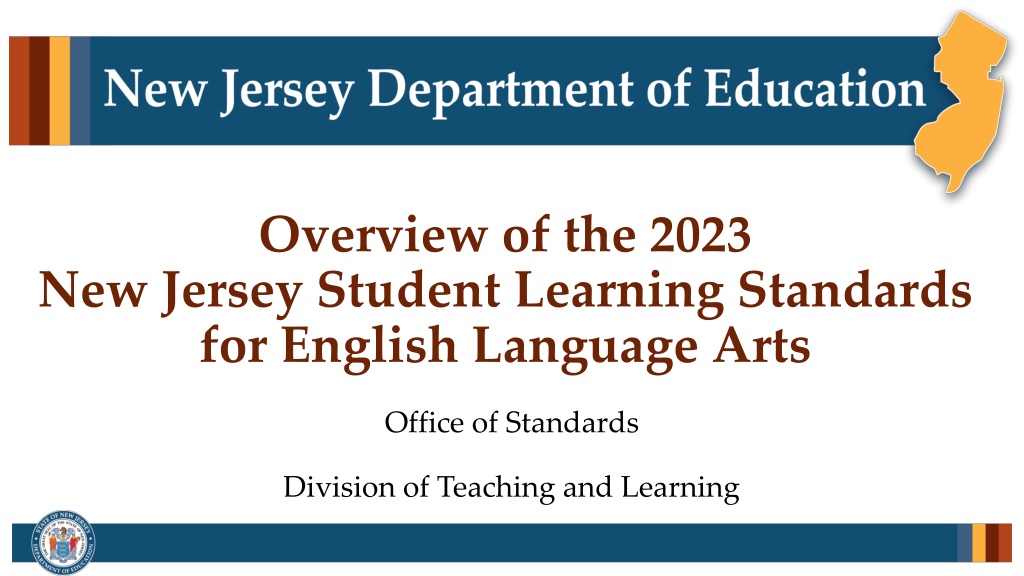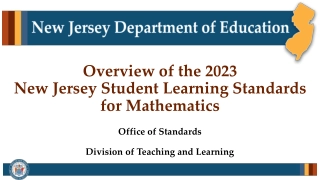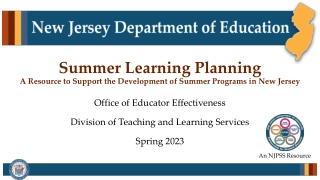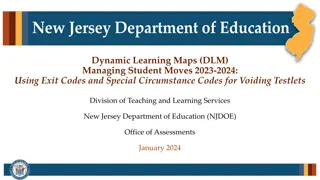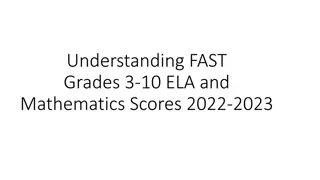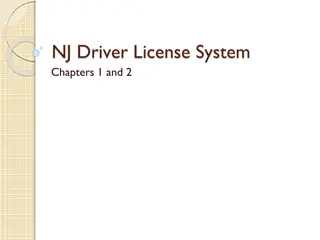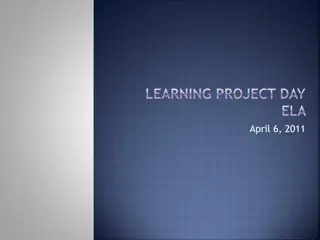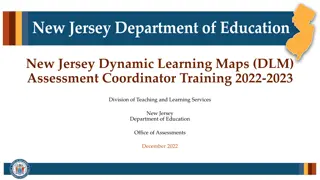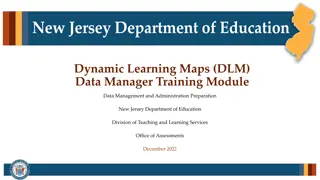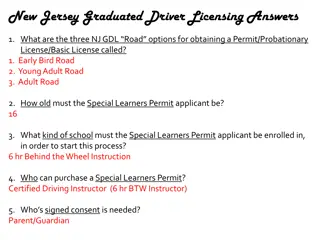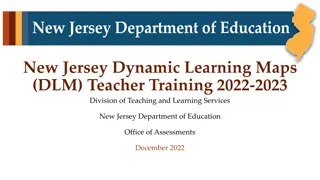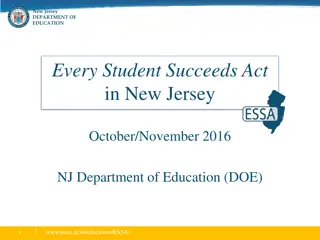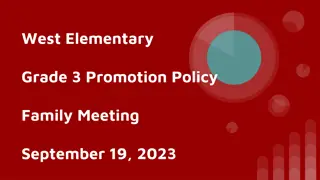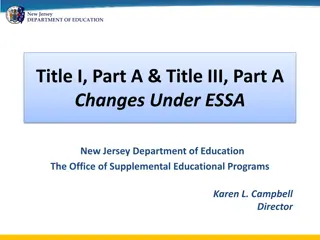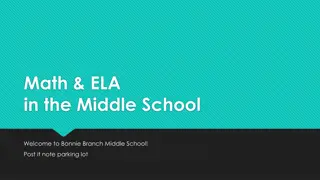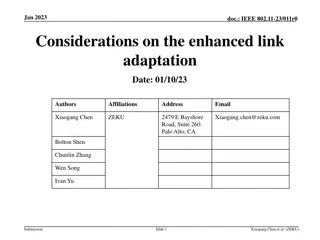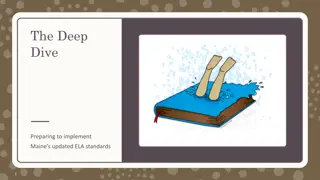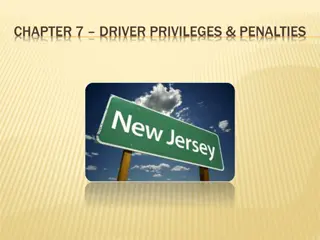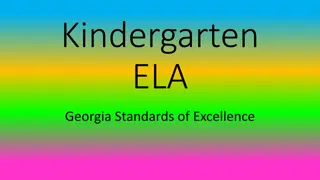New Jersey 2023 Student Learning Standards for ELA Overview
The 2023 New Jersey Student Learning Standards for English Language Arts introduce new features, restructuring, and adoption details. These standards aim to prepare students for college, career, and global citizenship by focusing on skills like responsibility for learning, communication adaptation, evidence valuation, knowledge building, and more. The standards cover domains such as reading, speaking, listening, writing, language, and foundational skills. The Companion Standards have been integrated to enhance the reading and writing expectations. Implementation is set for September 2024.
Download Presentation

Please find below an Image/Link to download the presentation.
The content on the website is provided AS IS for your information and personal use only. It may not be sold, licensed, or shared on other websites without obtaining consent from the author. Download presentation by click this link. If you encounter any issues during the download, it is possible that the publisher has removed the file from their server.
E N D
Presentation Transcript
Overview of the 2023 New Jersey Student Learning Standards for English Language Arts Office of Standards Division of Teaching and Learning
Contents Implementation date New features of the 2023 NJSLS-ELA Restructuring of the 2023 NJSLS-ELA Summary of Revisions and Examples Resources and supports 2
Adoption and Implementation NJSLS-ELA were adopted by the State Board of Education on October 4, 2023. The NJSLS-ELA will be implemented by LEAs in September, 2024. 3
New Features of the NJSLS-ELA An integrated vision has been crafted to describe how an ELA education in New Jersey will prepare students to meet the demands of college and career and engage as productive American citizens with global responsibilities. New ELA Practices describe the capacities held by students who have progressed through a kindergarten through grade 12 English Language Arts program in New Jersey, including: oDeveloping responsibility for learning oAdapting Communication oValuing Evidence in Argumentation oBuilding Knowledge oLeveraging Technology oUnderstanding Self and Others 4
Restructuring the NJSLS - ELA 2016 NJSLS-ELA Reading Companion Standards (6 12) Speaking and Listening Writing Language Reading Foundation Skills (K 5) Reading in History, Social Studies, Science and Technical Subjects Literary Text Writing in History, Social Studies, Science and Technical Subjects Informational Text 2023-NJSLS-ELA Speaking and Listening Language Reading Writing Foundational Skills: Reading Literary Text *The Companion Standards (6 12) were meaningfully integrated into the Reading Informational Text expectations. Foundational Skills: Writing *Informational Text
Text Version of Diagrams in Slide 5 2016 NJSLS-ELA 2023 NJSLS-ELA Four domains: Four domains plus either: Reading Domain: Reading Foundational Skills: Reading (Grades K 5); or Literary Texts Writing Informational Texts Companion Standards (Grades 6 12). Speaking and Listening Companion Standards: Language Reading in history, social studies, science, and technical subjects Four domains: Reading domain: Reading, Literary texts Writing, Writing in history, social studies, science, and technical subjects Informational Texts Language, and Language domain: Speaking and Listening. Foundation skills: reading Foundational skills: writing 6
Structural Terms (1 of 4) Domain: A category of related standards within English Language Arts. The ELA Domains are Language, Reading, Writing, and Speaking & Listening. 7
Structural Terms (2 of 4) Strand: Broad ideas developed over the course of Kindergarten through 12th grade that support students in meeting the Anchor Statements and Performance Expectations Reading Domain Anchor Statements Reading: Text complexity and the growth of comprehension (CR) Close Reading of Text: By the end of grade 12, read closely to determine what the text says explicitly and to make logical inferences and relevant connections from it; cite specific textual evidence when writing or speaking to support conclusions drawn from the text. (CI) Central Ideas and Themes of Texts: By the end of grade 12, determine central ideas or themes of a text and analyze their development; summarize the key supporting details and ideas. 8
Structural Terms (3 of 4) Anchor Statement: Expectations to be met for students to be prepared for post-elementary or post-secondary success. oAnchor Statements for Foundational Skills: Reading Language and Foundational Skills: Writing Language are to be met by the end of grade 5. oAnchor Statements for all other Domains and Strands are to be met by the end of grade 12. (WF) Foundational Skills: Writing Language: By the end of grade 5, develop understanding and conceptual knowledge of print, phonological processing, letter formation and handwriting, and other basic conventions of the English writing system. (SS) System and Structure of Language: By the end of grade 12, demonstrate command of grammar and usage, capitalization, punctuation, and spelling. (KL) Knowledge of Language: By the end of grade 12, apply knowledge of language and command of vocabulary to understand how language functions in different contexts, to make effective choices for meaning or style, and to comprehend more fully when reading or listening. 9
Structural Terms (4 of 4) Standard: Performance expectations to be met by the end of a grade level or a grade band. RL.CR.7.1. Cite several pieces of textual evidence and make relevant connections to support analysis of what a literary text says explicitly as well as inferences drawn from the text. RI.CR.7.1. Cite several pieces of textual evidence and make relevant connections to support analysis of what an informational text says explicitly as well as inferences drawn from the text. 10
How Standards Are Coded RL = Reading Literature CR = Close Reading of Text RL.CR.K.1 With prompting and support, ask and answer questions about key details in a literary text (e.g., who, what, where, when, why, how). 1 = Standard #1 K = Kindergarten 11
Structural Revisions: Language Domain Language Domain (2016 NJSLS-ELA) Language Domain (2023 NJSLS-ELA) Conventions of Standard English Knowledge of Language Vocabulary Acquisition & Use Foundational Skills: Reading (RF) Foundational Skills: Writing (WF) System and Structure of Language (SS) Knowledge of Language (KL) Vocabulary, Acquisition and Use: Literal Meaning (VL) Language Domain Vocabulary, Acquisition and Use: Interpretive Meaning (VI) 12
Language Domain: Reading Foundations The 2023 NJSLS-ELA prioritize the Language Domain to underscore the critical importance of developing Foundational Reading skills in grades K 5. K 5 Foundational Reading Skills (2023 additions): Decoding and encoding words Analyzing word parts Reinforcing awareness of segments of sounds in speech and how they link to letters Developing reading accuracy, fluency, and comprehension Highlighting broad oral language skills 13
K5 Foundational Reading Example 2016 NJSLS-ELA 2023 NJSLS-ELA RF.K.4. Read emergenttext with one- to-one correspondence to develop fluency andcomprehension skills. A. Read emergent-readers with purpose and understanding. B. Read grade level text for purpose and understanding. L.RF.K.4. Read emergent-reader texts (decodable texts, including words with one-to-one letter-sound correspondences) orally with sufficient decoding accuracy to support comprehension. 14
Language Domain: Writing Foundations The 2023 NJSLS-ELA prioritize the Language Domain to underscore the critical importance of developing Foundational Writing standards to complement the K 5 Foundational Reading standards. K 5 Foundational Writing Skills (new in the 2023 NJSLS-ELA) Emphasizing sound-letter basics Advancing letter formation skills and stamina-building Developing encoding and spelling skills Using elements of grammar, syntax, and punctuation in sentence composition Facilitating development of writing skills and habits 15
K5 Foundational Writing Example 2016 NJSLS- ELA n/a 2023 NJSLS-ELA L.WF.1.2. Demonstrate command of the conventions of encoding and spelling common, regular, single-syllable words with: A. Short vowels and single consonants B. Consonant graphemes including qu, x, and ck; digraphs (thin, shop, when, much, sing); and doubled letters (off, will, mess). C. Initial and final consonant blends (must, slab, plump). 16
Structural Revisions: Reading Domain Reading Domain (2016 NJSLS-ELA) Reading Domain (2023 NJSLS-ELA) Key Ideas and Details Craft and Structure Integration of Knowledge and Ideas Range of Reading & Level of Text Complexity Close Reading (CR) Central Ideas and Themes of Texts (CI) Interactions Among Text Elements (IT) Text Structure (TS) Perspective and Purpose in Texts (PP) Diverse Media and Formats (MF) Analysis of an Argument (AA) Comparison of Texts (CT) Language Domain 17
Reading Domain: Revisions Meaningfully integrates Companion Standards for Reading in History, Social Studies, Science, and Technical Subjects into Reading: Informational Text expectations for grades 6 12. Modifies redundant standards that were repeated across multiple grade levels. Clarifies changes in developmental complexity across grades. Delineates skills and knowledge related to literary text and informational text, including features and structures unique to each kind of text. 18
Reading Domain Example A: 2016 2016 NJSLS- Reading Informational Text 2016 NJSLS Reading Companion: History/Social Studies, Science and Technical Subjects RH.6-8.6. Identify aspects of a text that reveals an author's point of view or purpose (e.g., loaded language, inclusion or avoidance of particular facts). RH.6-8.6. Identify aspects of a text that reveals an author's point of view or purpose (e.g., loaded language, inclusion or avoidance of particular facts). RI.6.6. Determine an author's point of view or purpose in a text and explain how it is conveyed in the text RI.7.6. Determine an author's point of view or purpose in a text and analyze how the author distinguishes his or her position from that of others. 19
Reading Domain Example A: Revised 2016 NJSLS-ELA Companion Standards: Writing History/Social Studies, Science and Technical Subjects 2016 NJSLS-ELA Reading: Informational Text 2023 NJSLS-ELA RI.PP.6.5. Identify author's purpose, perspective or potential bias in a text and explain the impact on the reader's interpretation. RI.6.6. Determine an author's point of view or purpose in a text and explain how it is conveyed in the text. RH.6-8.6. Identify aspects of a text that reveals an author's point of view or purpose (e.g., loaded language, inclusion or avoidance of particular facts). RH.6-8.6. Identify aspects of a text that reveals an author's point of view or purpose (e.g., loaded language, inclusion or avoidance of particular facts). RI.PP.7.5. Determine how an author conveys or develops perspective or purpose in a text through distinguishing their position from that of others using evidence. RI.7.6. Determine an author's point of view or purpose in a text and analyze how the author distinguishes his or her position from that of others. 20
Reading Domain Example B: 2016 Grade 4 (Literary and Informational Texts) Grade 5 (Literary and Informational Texts) RL.4.1. Refer to details and examples in a text and make relevant connections when explaining what the text says explicitly and when drawing inferences from the text. RI.4.1. Refer to details and examples in a text and make relevant connections when explaining what the text says explicitly and when drawing inferences from the text. RL.5.1. Quote accurately from a text and make relevant connections when explaining what the text says explicitly and when drawing inferences from the text. RI.5.1. Quote accurately from a text and make relevant connections when explaining what the text says explicitly and when drawing inferences from the text. 21
Reading Domain Example B: Revised 2016 NJSLS-ELA 2023 NJSLS-ELA RL.4.1. Refer to details and examples in a text and make relevant connections when explaining what the text says explicitly and when drawing inferences from the text. RL.CR.4.1. Refer to details and examples as textual evidence when explaining what a literary text says explicitly and make relevant connections when drawing inferences from the text. RL.5.1. Quote accurately from a text and make relevant connections when explaining what the text says explicitly and when drawing inferences from the text. RL.CR.5.1. Quote accurately from a literary text when explaining what the text says explicitly and make relevant connections when drawing inferences from the text. 22
Literary and Informational Text Standards 2016 NJSLS-ELA 2023 NJSLS-ELA RL.8.1. Cite the textual evidence and make relevant connections that most strongly supports an analysis of what the text says explicitly as well as inferences drawn from the text. RL.CR.8.1. Cite a range of textual evidence and make clear and relevant connections to strongly support an analysis of multiple aspects of what a literary text says explicitly, as well as inferences drawn from the text. RI.8.1. Cite the textual evidence and make relevant connections that most strongly supports an analysis of what the text says explicitly as well as inferences drawn from the text. RI.CR.8.1. Cite a range of textual evidence and make clear and relevant connections (including informational text features such as charts, graphs, and diagrams) to strongly support an analysis of multiple aspects of what an informational text says explicitly, as well as inferences drawn from the text. 23
Structural Revisions: Writing Domain Writing Domain (2016 NJSLS-ELA) Writing Domain (2023 NJSLS-ELA) Text Types & Purposes Production & Distribution of Writing Research to Build & Present Knowledge Range of Writing Argumentative Writing (AW) Informative and Explanatory Writing (IW) Narrative Writing (NW) Writing Process (WP) Writing Research (WR) Sources of Evidence (SE) Range of Writing (RW) Language Domain 24
Writing Domain: Revisions Meaningfully integrates Companion Standards for Writing History, Science, and Technical Subjects into Writing expectations for grades 6 12. Delineates skills and knowledge related to types of writing, including eliminating redundancy and clarifying changes in developmental complexity across grade levels. Recognizes significant digital and virtual shifts in communication since the 2016 NJSLS-ELA by integrating and amplifying digital, interactive, graphic, and other non-traditional text formats. 25
Writing Domain Example A: 2016 2016 NJSLS-ELA Writing Grades 9-10, 11-12 W.9-10.5. Develop and strengthen writing as needed by planning, revising, editing, rewriting, trying a new approach, or consulting a style manual (such as MLA or APA Style), focusing on addressing what is most significant for a specific purpose and audience. W.11-12.5. Develop and strengthen writing as needed by planning, revising, editing, rewriting, trying a new approach, or consulting a style manual (such as MLA or APA Style), focusing on addressing what is most significant for a specific purpose and audience. 2016 NJSLS-ELA Writing Companion: History, Science and Technical Subjects WHST.9-10.5. Develop and strengthen writing as needed by planning, revising, editing, rewriting, or trying a new approach, focusing on addressing what is most significant for a specific purpose and audience. WHST.11-12.5. Develop and strengthen writing as needed by planning, revising, editing, rewriting, or trying a new approach, focusing on addressing what is most significant for a specific purpose and audience. 26
Writing Domain Example A: Grades 910 Revised 2023 NJSLS-ELA 2016 NJSLS-ELA Writing 2016 NJSLS Writing Companion W.9-10.5. Develop and strengthen writing as needed by planning, revising, editing, rewriting, trying a new approach, or consulting a style manual (such as MLA or APA Style), focusing on addressing what is most significant for a specific purpose and audience. WHST.9-10.5. Develop and strengthen writing as needed by planning, revising, editing, rewriting, or trying a new approach, focusing on addressing what is most significant for a specific purpose and audience. W.WP.9-10.4. Develop and strengthen writing as needed by planning, revising, editing, rewriting, trying a new approach; sustaining effort to complete complex writing tasks; seeking out feedback and reflecting on personal writing progress; consulting a style manual (such as MLA or APA Style), focusing on addressing what is most significant for a specific purpose and audience. 27
Writing Domain Example A: Grades 1112 Revised 2023 NJSLS-ELA 2016 NJSLS-ELA Writing 2016 NJSLS Writing Companion W.WP.11-12.4. Develop and strengthen writing as needed by planning, revising, editing, rewriting, trying a new approach; sustaining effort to complete complex writing tasks; tracking and reflecting on personal writing progress (e.g., using portfolios, journals, conferencing); or consulting a style manual (such as MLA or APA Style), focusing on addressing what is most significant for a specific purpose and audience. W.11-12.5. Develop and strengthen writing as needed by planning, revising, editing, rewriting, trying a new approach, or consulting a style manual (such as MLA or APA Style), focusing on addressing what is most significant for a specific purpose and audience. WHST.11-12.5. Develop and strengthen writing as needed by planning, revising, editing, rewriting, or trying a new approach, focusing on addressing what is most significant for a specific purpose and audience. 28
Writing Domain Example B 2016 NJSLS-ELA 2023 NJSLS-ELA W.1.1. Write opinion pieces in which they introduce the topic or name the book they are writing about, state an opinion, supply a reason for the opinion, and provide some sense of closure. W.AW.1.1. With prompts and support, write opinion pieces on a topic or texts. A. Introduce an opinion. B. Support the opinion with facts or other information and examples related to the topic. C. Provide a conclusion. W.2.1. Write opinion pieces in which they introduce the topic or book they are writing about, state an opinion, supply reasons that support the opinion, use linking words (e.g., because, and, also) to connect opinion and reasons, and provide a conclusion. W.AW.2.1. With prompts and support, write opinion pieces to present an idea with reasons and information. A. Introduce an opinion. B. Support the opinion with facts, definitions, concrete details, text evidence, or other information and examples related to the topic. C. Provide a conclusion. 29
Writing Domain Example C 2016 NJSLS-ELA 2023 NJSLS-ELA W.5.8. Recall relevant information from experiences or gather relevant information from print and digital sources; summarize or paraphrase information in notes and finished work, and provide a list of sources. W.SE.5.6. Gather relevant information from multiple valid and reliable print and digital sources; summarize or paraphrase information in notes and finished work, making note of any similarities and differences among ideas presented; and provide a list of sources. 30
Structural Revisions: Speaking & Listening Domain Speaking and Listening Domain (2016 NJSLS-ELA) Comprehension & Collaboration Presentation of Knowledge & Ideas Speaking and Listening Domain (2023 NJSLS-ELA) Participate Effectively (PE) Integrate Information (II) Evaluate Speakers (ES) Present Information (PI) Use Media (UM) Adapt Speech (AS) 31
Climate Change in NJSLS-ELA Standards accompanied by this icon: May be leveraged in support of climate change instruction Represent opportunities to integrate age-appropriate climate change education and resources May be used to support interdisciplinary learning opportunities. 32
Support and Resources Reading Acceleration Professionally Integrated Development (RAPID/RAPID+) will provide professional development resources in literacy in early and upper elementary grades STAMP (Standards Transparency and Mastery Platform) supports appearing in the coming weeks and months 33
What questions do you have? Have questions? Please email questions to ELA@doe.nj.gov 34
Follow Us on Social Media! Instagram: @newjerseydoe Facebook: @njdeptofed LinkedIn: New Jersey Department of Education X: @NewJerseyDOE YouTube: Threads: @NewJerseyDOE @newjerseydepartmentofeduca6565 35
